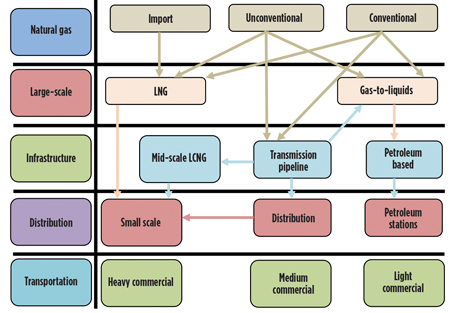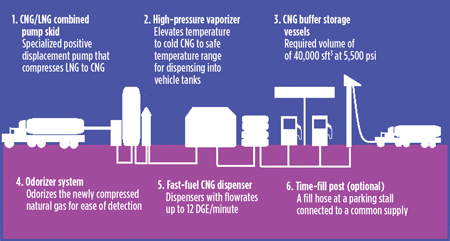Expansion of hybrid LNG and CNG fueling stations
Natural gas is anticipated to play a dynamic role in the global energy portfolio due to its increasing availability via pipeline, and in the form of liquefied natural gas (LNG) and compressed natural gas (CNG). Although natural gas vehicle (NGV) fueling stations are more difficult to maintain than traditional fueling stations, innovations are seen in this sector.
At hybrid fueling stations, LNG is compressed to more than 200-bar pressure and converted into CNG, so that both LNG and CNG vehicles can be fueled from the same station. These fueling depots are known as LCNG stations. These types of stations have been established in Brazil and Sweden, and in the US city of Los Angeles, California. The technical specifications and market promise for such fueling stations are discussed in detail here.
Hybrid stations for NGVs. To fight pollution created by diesel- and gasoline-fueled vehicles, NGV programs have been started up around the world.1 Natural gas has flexible applications related to the LNG and CNG sectors that will improve energy accessibility. NGV fleets are in demand in the city gas distribution (CGD) sector of many countries2 (Fig. 1).3
 |
| FIG. 1. LNG production and refueling options. |
In Europe, Spain is the main pioneer of using LNG as fuel. The country has approximately 16 fixed stations that offer LNG for light and heavy commercial vehicles. Similarly, the Netherlands has approximately eight operating LNG fueling stations and more than 100 LNG-fueled heavy vehicles on the road. Approximately 2.8 MM CNG vehicles are in use in India.4
Types of LNG and LCNG stations. LNG fueling stations are superior in terms of equipment, operating costs and safety. However, LCNG stations fill the demands of fueling for both LNG and CNG vehicles. LCNG refueling stations compress the LNG up to 300-bar pressure, and then the pressurized liquid is vaporized and heated for conversion into regasified LNG.
Two ways exist of converting LNG into CNG. The first is to compress the liquefied gas to a maximum pressure of 200 bar and then to heat it and vaporize it to make a gas. The other way to obtain CNG from LNG is to directly vaporize or heat gas from the tank, put the gas through an odorizer, and then compress the gas by using a standard gas compressor.
Generally, LNG and CNG stations have high capital and operating costs, while LCNG stations have high capital but low operating costs. An LCNG station with a refueling capacity of 1,000 sft3m and 14,000 gal of LNG storage at high-pressure cascade gas storage tanks has the low capital cost of a CNG station with the same cascade gas storage and refueling capacity.5 LNG and LCNG stations are categorized into permanent and mobile stations. The permanent stations are further divided into Types A, B, C, D and E, while the mobile stations are divided into Types 1 and 2. Fig. 2 shows the major components of LCNG stations.
 |
| FIG. 2. Components of a combined LNG and CNG (LCNG) fueling station. |
Technical specifications for LCNG. The fueling pressure for LCNG should be 200 bar at an intermediate storage pressure of 300 bar. The station flow range varies from 500 Nm3/hr–8,000 Nm3/hr. The flow regulation is controlled through a variable frequency drive (VFD), with an average refueling time of 3 min–4 min at 200 bar. The number of vehicles filled per hour is 12 vehicles per dispenser. The fueling flow per dispenser for LCNG is 70 Nm3/hr. The technical specifications for LCNG are described in Table 1.
 |
Permanent stations: Type A. The Type A station is the simplest station that includes all main equipment: a cryogenic storage tank, an LNG dispenser with a mass meter, a payment system, and a control panel located in a safe area or an explosion-proof enclosure on the programmable logic controller (PLC). The LNG is transferred by the means of differential pressure, and stored at a pressure of 7 bar–11 bar. The PLC validates the vehicles and controls the refueling process automatically.
Type A stations have low capital and operational costs, but they are not capable of fueling heavy commercial vehicles, as the space requirement for such stations is very low. The dispenser at these types of stations cannot be located far from the tank, as no pumping system is available. Since it is not possible to recover the boiloff from the tank, it must be custom designed to specific control system requirements.
Permanent stations: Type B. Station Type B is essentially an upgraded version of the Type A station with the addition of a boiloff recovery system, which makes possible the supply of CNG from the same station to light commercial vehicles. By using boiloff, Type B LNG stations become more flexible.
The station consists of two units—one for LNG and the other for CNG. The LNG unit consists of a cryogenic LNG storage tank, an LNG dispenser with a mass meter and a payment system, and an odorizing system. The CNG unit consists of a CNG compressor featuring a gas compressor with blowdown vessels, high-pressure storage vessels and a CNG dispenser, along with the control panel based on PLC.
Type B stations have moderate capital and operational costs, and they offer the possibility of fueling both LNG and CNG vehicles. In this case, the LNG dispensers cannot be allocated far from the tank.
Permanent stations: Type C. Station Type C changes the transfer system of LNG by using centrifugal cryogenic pumps. The equipment configuration includes cryogenic LNG storage tanks, centrifugal cryogenic pumps, an LNG dispenser and a control panel based on PLC. An LNG dispenser at a Type C station does not need to be kept near the storage tank, and it has high refueling capacity.
Permanent stations: Type D. Station Type D is the upgraded form of Type B and Type C stations with the addition of a boiloff recovery system. The equipment configuration includes a cryogenic LNG storage tank, a centrifugal cryogenic pump, an LNG dispenser, an odorizing system, CNG compression units and a control panel based on PLC. In Type D stations, the LNG dispenser does not need to be located near the storage tank. It has a high capacity for both LNG and CNG fueling.
Permanent stations: Type E. Station Type E is an integrated station that allows for LNG fueling at different equilibrium pressures. One of the principal features is a system that enables saturation of the LNG prior to refueling between the pump skid and the dispenser. This system may be repeated to obtain several filling pressures. The 3-bar storage pressure can be increased at 7 bar/8 bar, which can also be increased up to 18 bar. Type E stations can refuel both LNG and CNG vehicles. They have a high refueling capacity, and do not require a minimum number of LNG trucks if the CNG sales volume is adequate.
Mobile stations: Type 1. Type 1 is the simplest form of mobile station. It can be installed on a 20-in. or 40-in. platform. It requires cryogenic equipment, manual valves, a hose/nozzle and a cryogenic pump. It has very low capital and operational cost, along with fueling flexibility.
Mobile stations: Type 2. Type 2 is the upgraded version of the Type 1 station. It requires a 40-in. platform to be installed and includes a dispenser. Its equipment configuration includes a 20-in. cryogenic ISO container, an LNG dispenser, a control panel designed for a classified area and a cryogenic pump.
Countries including Spain, the UK, the Netherlands, Sweden and Portugal have LCNG stations that are widely used for the refueling of LNG and CNG stations.
Takeaway. Hybrid LCNG fueling stations are used in Spain, the UK, the Netherlands and other European countries for the fueling of both LNG and CNG vehicles. The possibility for such stations to be established in India is strong, but this will require an infrastructure buildout and an expansion of the country’s NGV fleet. GP
Literature cited
- Narain, U. and A. Krupnick, “The impact of Delhi’s CNG program on air quality,” 2007.
- Mathur, A. S., “Petroleum and natural gas statistics 2014–2015,” India Ministry of Petroleum and Natural Gas, September 2015.
- Wegrzyn, J. E. and W. L. Litzek, “Natural gas as a fuel option for heavy vehicles,” Sae Technical Paper Series, 1999.
- Ellinas, C., “Promoting natural gas vehicles in India,” Natural Gas World, Vol. 1: 18–20, August 2016.
- Zeus Development Corp., “LNG vehicle markets and infrastructure,” Report prepared by Zeus Development Corp. for Gas Research Institute, March 1998.
 |
Anirbid Sircar is the Director of the School of Petroleum Technology at Pandit Deendayal Petroleum University in Gandhinagar, India, as well as the Head of the University’s Centre of Excellence for Geothermal Energy. Dr. Sircar has 21 yr of industrial and academic experience. He graduated from the Indian Institute of Technology at Kharagpur with a Master of Technology degree in petroleum, and he received a PhD in reservoir tomography from the Indian School of Mines at Dhanbad. His research interests include petroleum exploration, geothermal energy, reservoir tomography, shale gas exploration and city gas distribution. Dr. Sircar has authored a book, City Gas Distribution: An Indian Perspective, and has published more than 50 research papers in national and international journals. He has also applied for a patent in the field of integrated space heating and cooling.
 |
Kriti Yadav is a Research Associate at the Centre of Excellence for Geothermal Energy at Pandit Deendayal Petroleum University. Her present research projects are in the fields of geothermal energy and city gas distribution. She is pursuing a PhD in geothermal energy from PDPU, and she holds an MS degree in geology from Patna University. Ms. Yadav is an active researcher with the team involved in space heating and cooling plants at Dholera, Gujarat. She has also authored several papers on petroleum engineering.




Comments